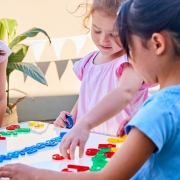How Can Play be Facilitated in Children with Special Needs?
The Importance of Playing
Contrary to some old-fashioned beliefs, playing is not a frivolous pursuit with no value, it does in fact play a critical role in the healthy brain development of babies and children. Play is so important to optimal child development that it has been recognized by the United Nations High Commission for Human Rights as a right of every child.
The impulse to play is innate but is not always so straightforward for children with special needs.
When Playing Doesn’t Come Easy
Children with autism often don’t play in the same way that neurotypical children do, and many engage in activities that may look nothing like play to the untrained eye. Even at a very young age, kids with autism are more likely to line toys or objects up, play by themselves, and repeat the same actions over and over again. They’re also less likely to engage in games that require “make-believe,” collaboration, or social communication.
They may instead show interest in non-toy objects and get enjoyment from things like counting or sorting objects. This is still playing and can be encouraged by providing toys that support their interest, such as an abacus or these wild animal counters. Children with autism also enjoy and benefit from repetition or lining toys up, so these linking rocks would be a great resource.
Children with attention deficit hyperactivity disorder (ADHD) may also struggle to play socially if they are prone to impulsivity as this often causes difficulty in turn-taking or maintaining focus. However, play allows children with ADHD the chance to express themselves and gives them an appropriate opportunity to expel pent-up energy. Toys that encourage social play, such as this activity tray can help children with ADHD or other special needs build relationships with other children. Toys and games that satisfy a child with ADHD’s need for movement are a brilliant and therapeutic way to support play. Anything physical, like this whizzy dizzy is a great way to let of steam.
Toys that Facilitate Play for Children with Special Needs
Early childhood special education can be enriched with learning through play:
- Maths Toys – These bear counters help develop early maths skills by introducing concepts like sorting, counting, sequencing, and basic addition and subtraction skills. By using the tweezers to manipulate the bears, children learn hand-eye coordination skills, as well as fine and gross motor skills. The bright colours and tactile texture make for an appealing toy that children of all abilities will find engaging.
- Lacing Beads – Beads for stringing/lacing such as these lacing buttons are perfect for supporting the development fine of motor needs. They can be played with as a solitary activity if a child needs a peaceful retreat from noisier activities or, alternatively, can be a fun group activity that encourages peer interaction and the development of social skills.
- Visual Supports – Children with special needs tend to process information more effectively when new concepts are introduced with accompanying visual supports. Instead of giving written or spoken instructions, you might find the child is more likely to retain the information with toys that support the relevant concept. Fundamentals of mathematics are easier for children with special needs if they are taught with accompanying manipulatives, like these geometry supports.
All children learn through play, and those with special needs are no different. In fact, play-based learning can support the specific difficulties your child might have.
For example, if your child has a hearing or visual impairment, play can help strengthen their other senses to help them navigate and explore the world. If they have a mobility impairment, play can exercise their muscles and improve coordination. The appealing nature of play is a natural motivator for engaging children in learning without it feeling like a chore.
Educators and parents should find play opportunities that encourage social and imaginative play by providing toys that support their interests and needs. Remember to adapt to your child so they can get the most out of their play experience. For example, if they are hypersensitive, introduce new toys carefully, and be aware of those they do not like.
If the child has a physical disability, make sure the chosen activities and toys are accessible to them.



